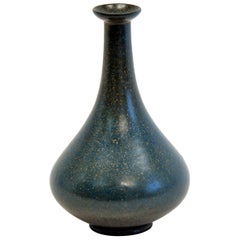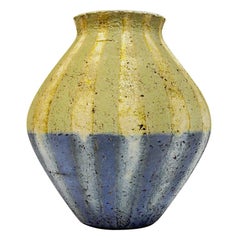Blue Vintage Vase 16 Cmh
Recent Sales
1960s Swedish Scandinavian Modern Blue Vintage Vase 16 Cmh
Stoneware
1960s Swedish Scandinavian Modern Blue Vintage Vase 16 Cmh
Ceramic
A Close Look at scandinavian-modern Furniture
Scandinavian modernism is perhaps the warmest and most organic iteration of modernist design. The work of the designers associated with vintage Scandinavian modern furniture was founded on centuries-old beliefs in both quality craftsmanship and the ideal that beauty should enhance even the humblest accessories of daily life.
ORIGINS OF SCANDINAVIAN MODERN FURNITURE DESIGN
- Emerged in the 1930s
- Originated primarily in Denmark, Sweden and Finland
- Introduced in the United States in mid-20th century
- Informed by the Bauhaus and modernism; influenced American mid-century modernism
CHARACTERISTICS OF SCANDINAVIAN MODERN FURNITURE DESIGN
- Bold, clean lines and simple, sturdy symmetries
- Use of natural materials — native woods such as pine, ash and beech
- Open, airy spaces
- Promotion of functionality
- Emphasis on craftsmanship; rooted in cabinetry profession and traditional construction techniques
- Minimal ornamentation (little to no embellishment)
- A neutral or light color palette owing to prominence of light woods
SCANDINAVIAN MODERN FURNITURE DESIGNERS TO KNOW
- Alvar Aalto
- Hans Wegner
- Kaare Klint
- Arne Jacobsen
- Greta Magnusson Grossman
- Finn Juhl
- Arne Vodder
- Verner Panton
ICONIC SCANDINAVIAN MODERN FURNITURE DESIGNS
VINTAGE SCANDINAVIAN MODERN FURNITURE ON 1STDIBS
The gentle, organic contours that are typical of Scandinavian design appear in the furnishings and decor created by Danish, Finnish and Swedish designers not as a stylistic gesture, but rather as a practical, ergonomic — and, as importantly, elegant — response to the human form.
Each nation produced exceptional talents in all areas of the applied arts, yet each had its forté. Sweden was home to Greta Magnusson Grossman and Bruno Mathsson — creators of the classic Grasshopper lighting series and Berlin daybed, respectively — but the country excelled most notably at ceramics. In the 1920s at the great Gustavsberg porcelain manufactory, Wilhelm Kåge introduced pieces in the Scandinavian style based on influences from folklore to Cubism; his skills were passed on to his versatile and inspired pupils Berndt Friberg and Stig Lindberg.
Likewise, Finland produced a truly ingenious Scandinavian modern furniture designer in the architect Alvar Aalto, a master at melding function and artistic form in works like the Paimio chair, created in collaboration with his first wife, Aino. Yet Finnish glassware was pre-eminent, crafted in expressive, sculptural designs by Tapio Wirkkala and Timo Sarpaneva.
The Danes excelled at chairs. Hans Wegner and Arne Jacobsen were exemplars of the country’s facility with wood, particularly teak.
Wegner created such iconic pieces as the Round chair and the Wishbone chair; Jacobsen — while the revolutionary architect and furniture innovator produced the best-selling plywood Ant chair — designed two classic upholstered pieces of the 1950s: the Swan chair and Egg chair. The list of great Danes could go on and on, including Finn Juhl, a stylistic maverick and maker of the bold Chieftain chair; Poul Kjaerholm, with his lean metal-and-rattan aesthetic; and Verner Panton, who introduced a vibrant Pop note into international design.
Today, decades after their heyday, the prolific, ever-evolving Scandinavian modernists continue to amaze and delight, and interior designers all over the world use their pieces to bring warmth to any given space.
On 1stDibs, you will note both instantly recognizable vintage Scandinavian modern chairs, sofas, rugs and tables — those that have earned iconic status over time — and many new discoveries.
Finding the Right urns for You
Decorative vases and antique and vintage urns are statement objects for the home that can date back centuries. Ranging from pieces with intricate, hand-painted details to more minimal forms with abstract shapes, decorative vases and urns come in a range of styles and sizes.
An urn is a type of vase that typically has a cover, a narrow neck and a round body, sometimes with a footed pedestal. However, when a vessel is called an urn, this often denotes its purpose rather than its origin or shape. One of the urn’s most crucial roles was and remains to be to hold the ashes of people for funerary rites. Another type of urn is adorned with figures that tell a story or show a scene.
Some of the earliest vases were formed from clay or metal-like bronze. Mesopotamians used them not only for decoration but also for storage. In ancient Greece, vases and urns frequently depicted stories from mythology, showing images of the gods and heroes. In ancient Egypt, vases such as the amphora had ceremonial purposes.
Over time, vases grew in popularity among artists as a different kind of canvas for expression. Unlike many of the ancient examples, these vases were not always functional but instead made for a striking addition to one’s decor. Even a plain, solid-colored vase can add color or style to a room. Metal urns are elegant additions to your living room or foyer rather than outside, unless you’re partial to the alluring weathered patina that is expected to characterize an antique cast-iron garden urn.
Every interior designer will tell you that decorative objects are what make a house a home. Decorative objects trumpet the homeowner’s personality while bringing a room to life. For designers, they present an opportunity to express their creative vision.
When looking for a decorative vase, it’s important to note the design and also the size and shape. Decorative vases vary from those with a wide base to those with long slender necks. Browse decorative vases and an extensive ceramic urn collection on 1stDibs.

